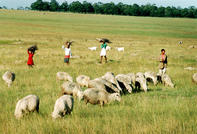Food Supply from Rural Areas
Money is not the only kind of resource that gets funnelled back and forth along migration routes – although, globally, cash remittances now make up over US$250 billion annually, a third of which is moving from one developing region to another.

‘Remittances in the form of goods and commodities are also extremely important,’ says a 2006 report by the South African Migration Project (SAMP), ‘as are internal remittances from urban and rural areas within countries.’ In the eleven cities surveyed in the SADC region by the African Food Security Urban Network (AFSUN), just over a quarter of all households reported getting food in the form of transfers from outside the city.
‘Urban households in the global south, and sub-Saharan Africa in particular, do rely to varying degrees on a supply of food from the rural areas in order to survive within hostile urban environments,’ writes Dr Bruce Frayne at Ontario’s University of Waterloo, Canada.
Helping a Household Feed Itself
Food is moving between communities and countries in surprisingly unexpected ways, notes Frayne’s colleague, geographer Dr Jane Battersby, Cape Town coordinator of AFSUN. One instance is how many people in the rural Eastern Cape – the headwaters of a strong and steady flow of migrants from the former homelands of the Ciskei and Transkei down to Cape Town – were sending food down to their relatives in Cape Town.
It is counter-intuitive – you would think the city-living wage earner would be sending food back home to the poorer, rural relatives, when actually the opposite appears to be true at times. The kinds of foods being sent to city relatives in the SADC region are cereals, for the most part, but also vegetables, nuts, beans, pulses and meat, including red meat, poultry and offal.
In the survey, the vast majority of families said they were sent food ‘to help the household feed itself’, while 20% said the food was sent as a gift. Once the food arrived, only a tiny amount (3%) was sold, indicating how important this kind of food flow is for a family’s food security status. It is food to eat, rather than something that is used as an income earner.
City-to-City Food Transfers
Some of the food is moving from rural areas into the city, but some also goes from city to city. ‘The cycle of agricultural production will determine to a large degree the availability of food, with transfers taking place after harvest, which may only be once or twice a year,’ writes Frayne.
This determines what kind of food gets sent from the countryside, and when. But with city-to-city food transfer, the availability of food is not dependent on seasonality, so the time and kind of food flow will be different.
The flow of food along these migration routes tends to be more seasonal and irregular than, say, food that is available inside the city in shops, but is nevertheless an important part of poorer households’ coping strategies. These kinds of social networks underpin migration, write Jonathan Crush and Bruce Frayne in a report for AFSUN in 2010.
By Leonie Joubert